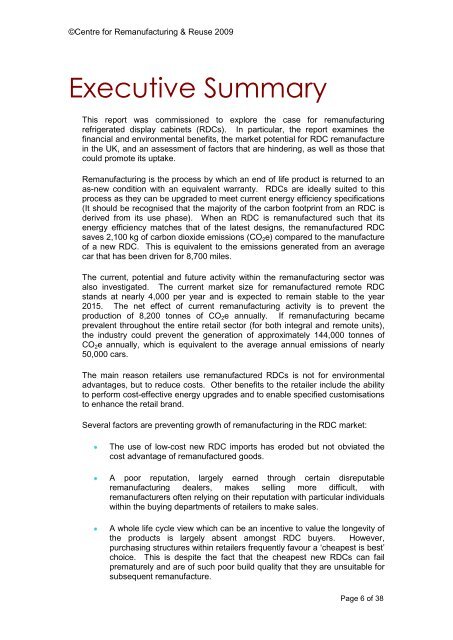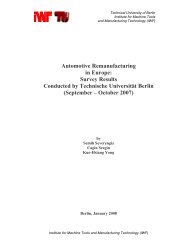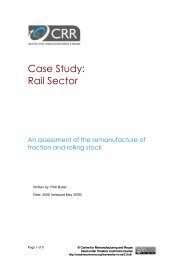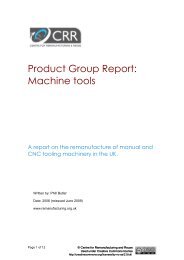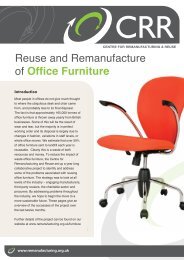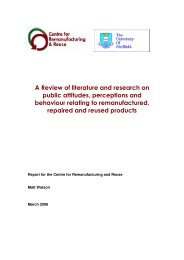Report on the remanufacturing of refrigerated display cabinets
Report on the remanufacturing of refrigerated display cabinets
Report on the remanufacturing of refrigerated display cabinets
Create successful ePaper yourself
Turn your PDF publications into a flip-book with our unique Google optimized e-Paper software.
©Centre for Remanufacturing & Reuse 2009<br />
Executive Summary<br />
This report was commissi<strong>on</strong>ed to explore <strong>the</strong> case for <strong>remanufacturing</strong><br />
<strong>refrigerated</strong> <strong>display</strong> <strong>cabinets</strong> (RDCs). In particular, <strong>the</strong> report examines <strong>the</strong><br />
financial and envir<strong>on</strong>mental benefits, <strong>the</strong> market potential for RDC remanufacture<br />
in <strong>the</strong> UK, and an assessment <strong>of</strong> factors that are hindering, as well as those that<br />
could promote its uptake.<br />
Remanufacturing is <strong>the</strong> process by which an end <strong>of</strong> life product is returned to an<br />
as-new c<strong>on</strong>diti<strong>on</strong> with an equivalent warranty. RDCs are ideally suited to this<br />
process as <strong>the</strong>y can be upgraded to meet current energy efficiency specificati<strong>on</strong>s<br />
(It should be recognised that <strong>the</strong> majority <strong>of</strong> <strong>the</strong> carb<strong>on</strong> footprint from an RDC is<br />
derived from its use phase). When an RDC is remanufactured such that its<br />
energy efficiency matches that <strong>of</strong> <strong>the</strong> latest designs, <strong>the</strong> remanufactured RDC<br />
saves 2,100 kg <strong>of</strong> carb<strong>on</strong> dioxide emissi<strong>on</strong>s (CO 2 e) compared to <strong>the</strong> manufacture<br />
<strong>of</strong> a new RDC. This is equivalent to <strong>the</strong> emissi<strong>on</strong>s generated from an average<br />
car that has been driven for 8,700 miles.<br />
The current, potential and future activity within <strong>the</strong> <strong>remanufacturing</strong> sector was<br />
also investigated. The current market size for remanufactured remote RDC<br />
stands at nearly 4,000 per year and is expected to remain stable to <strong>the</strong> year<br />
2015. The net effect <strong>of</strong> current <strong>remanufacturing</strong> activity is to prevent <strong>the</strong><br />
producti<strong>on</strong> <strong>of</strong> 8,200 t<strong>on</strong>nes <strong>of</strong> CO 2 e annually. If <strong>remanufacturing</strong> became<br />
prevalent throughout <strong>the</strong> entire retail sector (for both integral and remote units),<br />
<strong>the</strong> industry could prevent <strong>the</strong> generati<strong>on</strong> <strong>of</strong> approximately 144,000 t<strong>on</strong>nes <strong>of</strong><br />
CO 2 e annually, which is equivalent to <strong>the</strong> average annual emissi<strong>on</strong>s <strong>of</strong> nearly<br />
50,000 cars.<br />
The main reas<strong>on</strong> retailers use remanufactured RDCs is not for envir<strong>on</strong>mental<br />
advantages, but to reduce costs. O<strong>the</strong>r benefits to <strong>the</strong> retailer include <strong>the</strong> ability<br />
to perform cost-effective energy upgrades and to enable specified customisati<strong>on</strong>s<br />
to enhance <strong>the</strong> retail brand.<br />
Several factors are preventing growth <strong>of</strong> <strong>remanufacturing</strong> in <strong>the</strong> RDC market:<br />
The use <strong>of</strong> low-cost new RDC imports has eroded but not obviated <strong>the</strong><br />
cost advantage <strong>of</strong> remanufactured goods.<br />
A poor reputati<strong>on</strong>, largely earned through certain disreputable<br />
<strong>remanufacturing</strong> dealers, makes selling more difficult, with<br />
remanufacturers <strong>of</strong>ten relying <strong>on</strong> <strong>the</strong>ir reputati<strong>on</strong> with particular individuals<br />
within <strong>the</strong> buying departments <strong>of</strong> retailers to make sales.<br />
A whole life cycle view which can be an incentive to value <strong>the</strong> l<strong>on</strong>gevity <strong>of</strong><br />
<strong>the</strong> products is largely absent am<strong>on</strong>gst RDC buyers. However,<br />
purchasing structures within retailers frequently favour a „cheapest is best‟<br />
choice. This is despite <strong>the</strong> fact that <strong>the</strong> cheapest new RDCs can fail<br />
prematurely and are <strong>of</strong> such poor build quality that <strong>the</strong>y are unsuitable for<br />
subsequent remanufacture.<br />
Page 6 <strong>of</strong> 38


